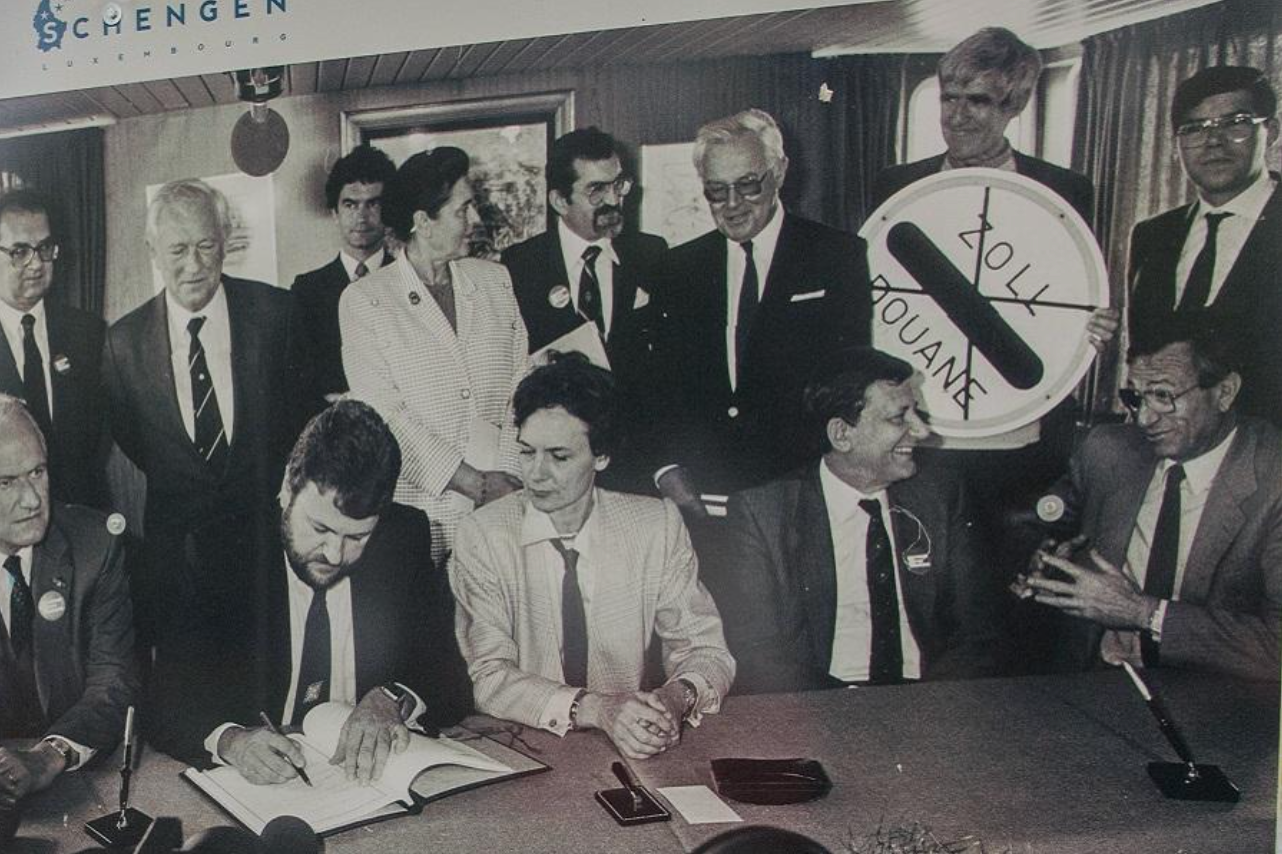“The decision to abolish internal border controls reflected a collective desire to overcome the divisions of the Cold War and to foster unity and peace” – so says the European Union, in the 40th year since the Schengen area was born.
The plan for Europe without frontiers was first revealed in 1985 aboard a vessel symbolically floating in the Moselle river beside the Luxembourg village of Schengen – just where the Grand Duchy meets both France and Germany.
Symbolically, the 2009 Nato summit was held jointly by Strasbourg in France and Kehl in Germany. They are linked by a series of bridges across the Rhine, and an international tram runs between the two communities.
During the Nato event, the French customs post was burned down by anarchists. No one cared much at the time, thinking it was obsolete.
By 2011, most European Union member states had been joined in the frontier-free zone by Iceland, Norway, Switzerland and plucky Liechtenstein. The aim: people could travel from Lapland to the Mediterranean without encountering any border friction.
Soon, though, controls began to reappear – at international railway stations, ferry ports and road crossings. This week the UK Foreign Office warned of the widespread reintroduction of border checks entering the Netherlands, Belgium and Germany. These are the key questions and answers.
What is the big idea of the Schengen area?
The plan: “The abolition of internal border controls between participating nations and simultaneously strengthening the protection of the common external borders.”
The EU adds: “Schengen is a fundamental part of the European identity. By removing internal borders, it has transformed the way people live, work, and travel.
“Every day, over 3.5 million people cross internal borders for work, study, or to visit family and friends, without any additional paperwork and, in the vast majority of cases, without additional waiting times. This is not just about saving time at the border – it also reduces costs, fosters talent mobility, and brings Europeans closer together.”

So what is happening now?
Each member state is entitled to reintroduce border controls, but the EU says this option “should only be used as a measure of last resort”.
Many Schengen area nations are availing of the option “of temporarily reintroducing border control at the internal borders in the event of a serious threat to public policy or internal security”.
From Amsterdam airport and the ferries that shuttle across the Rhine between France and Germany, to major motorway and rail routes through Iberia and the Balkans, checks are being reintroduced.
What are the justifications?
Mostly, fears about terrorism and irregular migration. France justifies the reimposition of control because of “serious threats” posed by “persistent jihadist threats”.
The nation is also concerned about: “Irregular migration flows towards the Franco-British border that risk infiltration by radicalised individuals, as well as the irregular crossings on the Channel and North Sea borders, along with rising violence among migrants, particularly in northern coastal areas such as Dunkirk and Calais.”
Germany has reintroduced checks on all its frontiers, citing: “Serious threats to public security and order posed by continued high levels of irregular migration and migrant smuggling, and the strain on the asylum reception system.”
Sweden is alarmed by “organised cross-border crime and terrorism, highlighted by attacks involving military-grade explosives against foreign institutions and the public”. It also specifies “the involvement of foreign state actors leveraging criminal gangs, coupled with persistent threats from violent Islamist groups and individuals”. And Norway names “threats of sabotage posed by the Russian intelligence service”.
Must I carry my passport?
Yes. You need a valid passport at all times when crossing borders within the Schengen area. This may be easy to overlook in locations such as Basel in Switzerland when France and Germany are just a stroll away, or if you are staying in the Slovakian capital, Bratislava and decide to visit the neighbouring Austrian capital, Vienna, for the day.
What will I find when crossing borders within the Schengen area?
The German government says: “The complete package of stationary and mobile border policing measures, including the possibility to refuse entry at the border, will be applied at all of Germany’s land borders as allowed by EU and national law.
“The border policing measures will continue to be carried out as required by the situation and flexibly in terms of time and place.”
In practice, the exact nature of the checks will depend on the mode of transport and the degree of perceived threat.
Rail
On international trains, frontier officials are likely to inspect travel documents on the move. Crossing from Salzburg in Austria towards Munich in Germany, for example, German border guards board westbound international trains at Salzburg. They check papers for about 15 minutes and then the train drops them off at a special officials-only stop.
At railway stations where international trains arrive, border police may inspect documents as passengers leave the platform. This has happened at Port Bou in Spain, where trains arrive from France.
Often, passengers will be targeted on the basis of their appearance, possessions or behaviour.
For example, Italy is concerned about the “threat of terrorist infiltrations into migratory flows along the Western Balkan route”. Officials may focus on people who look as though they might be part of those flows.
Road
At international frontiers, traffic may be slowed and confined to a single lane, with police observing each vehicle and deciding whether or not to stop it to check the occupant and any cargo that it contains. Prepare to be flagged down.
Anticipate that any drive that includes a frontier crossing will take longer than you think; while holiday motorists are unlikely to be closely examined, the congestion created by the border checks slows everyone down.
Ferry
On longer-distance, large ferries, such as those shuttling around the Baltics, the checks will be made on arrival. For smaller crossings, such as those across rivers, frontier police may be stationed on either side.
Air
While air travel within the Schengen area is supposed to be low-friction, there is the standard need to show your passport when boarding a flight as an identity check. In addition, passengers may be checked on arrival as part of the process for controlling migration.
Could some frontiers actually close?
Yes, in order to funnel travellers for inspection at the main frontier points, minor cross-border roads may be closed.
The European Union publishes a comprehensive list of frontier crossings, which reveals that a couple of ferry links connecting Slovakia with Austria and Hungary are among the borders that are now shut.
How long will these border controls last?
With no sign of an end to irregular migration, EU member states will want to assert their rights to impose whatever controls they wish. Given the perceived threats, it seem unlikely that they will soften their approaches any time soon.
For more travel news and advice, listen to Simon Calder’s podcast







